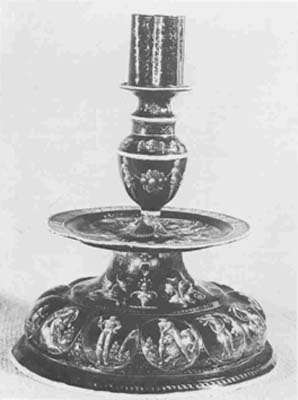
Annual Bulletin 6, 1982-1983
Home
Français
Introduction
History
Annual Index
Author &
Subject
Credits
Contact

Four Sixteenth-Century Painted Enamels
by Philippe Verdier
Pages 1
| 2 | 3
| 4
| 5
Pair of candlesticks, Master I. C., third quarter of the sixteenth
century (25) (fig. 14)
A large number of enamels bear the initials "I.
C.". On these candlesticks
they appear under the flanges. The initials are thought to stand for "Jean
Court." Is this the enameller Jean de Court, who was also an official painter
and was greatly esteemed in the Valois court, judging by his high salary
of 480 francs a year in the last period of his life, 1580-1585? (26) The domed
base of the candlesticks was executed in repoussé, with twelve painted
enamel ovals on a black background. On the first candlestick, the ovals
portray the twelve labours of Hercules, and are based on the engravings
that Heinrich Aldegrever executed in 1550 from his own drawings. (27) On the
other candlestick, the ovals depict twelve gods and goddesses of Olympus,
after the engravings of the Protestant artist Étienne Delaune, inspired
by Italian compositions. The base of each candlestick is connected by a
scotia to the flange, which is fixed and flat. One of the flanges is decorated
with a procession of musician amorini accompanying a putto astride
a billy goat (fig. 15a), after another engraving by the Master of the Die
(Bartsch 36), copying a Raphael drawing. On the other flange, there is
a similar procession of amorini escorting Cupid, a putto carried
in triumph in a chariot drawn by two goats, after an engraving by the Master
of the Die (Bartsch 37), reproducing a Raphael drawing (fig. 15b). Master I. C. took some liberties with respect to his models, made some additions
and removed the wings from his amorini. (28) Above the flanges, a baluster
stem supports the socket for the candle or resin torch. The flange edges
are decorated with ova, punctuated by four masks, some with feather head-dresses
like those of Indians. (29) The baluster stem is decorated with caryatids,
heads of cherubs, a festoon and bunches of fruit. The upper part is painted
with gilt arabesques on a blue background.
This type of candlestick was still in use in France under Louis
XIII (1601-1643). (30) The decoration on this pair constitutes a good example
of the Limoges enamellers' use of engraved models and
the combinations they created, for purely decorative purposes, using motifs
drawn from all types of engravings. Three pairs of candlesticks signed I. C.," and a fourth pair from his studio appeared in the large exhibition
at the South Kensington (now Victoria and Albert) Museum in 1862. (31) The
embossed ovals of a single candlestick, in the Frick Collection in New
York, feature six labours of Hercules alternating with six divinities,
after the engravings by Heinrich Aldegrever and Étienne Delaune.
The whereabouts of the other candlestick, with the twelve complementary designs, is
unknown. (32) Two
similar but incomplete candlesticks are in the Louvre. (33) Two bases of a
similar pair are at the Musées royaux d'art et d'histoire in Brussels
(nos 2238, a-b).
Next Page | Notes 1 to 21
1
| 2 | 3
| 4
| 5
Annual Index | Author & Subject | Credits | Contact
This digital collection
was produced under contract to Canada's Digital Collections program,
Industry Canada.
"Digital
Collections Program, Copyright
© National Gallery of
Canada 2001"